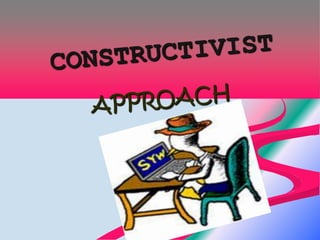Constructivist approach
- 2. ‚óòBelieves that KNOWLEDE cannot be passed on from one person to another 2
- 3. 3
- 4. 4
- 5. 5
- 6. 6
- 7. 7
- 8. 8
- 9. 9
- 10. WEAKNESS STRENGTH In a situation where The goal is to train conformity is essential learners to do a task the divergent thinking & same way to enable action may cause problem. consistency EXAMPLE: EXAMPLE: -Imagine the fun revenue -Logging onto & off of a Canada would have it workplace computer is the every person decided to same for all employee; it report their taxes in may be important to an their own way, although, exact routine to avoid there probably are some problems very “constructive” approaches used w/n the system we have (SCHUMAN,1996) 10
- 11. ENGAGE ‚ñ∫start the process EXPLORE ‚ñ∫provide students w/ a common base of experience ‚ñ∫identify & develop concepts, processes & skills 11
- 12. EXPLAIN ‚ñ∫opportunities to verbalize students conceptual understanding / to demonstrate new kills/behavior ‚ñ∫also provides an opportunities for teachers to introduce formal terms, definitions, & explanations for concepts, etc. 12
- 13. ELABORATE ►extend student’s conceptual understanding & allows them to practice skills & behaviors EVALUATE ►encourage learners & assess their understanding & abilities & lets teachers evaluate students understanding of key concepts & skill development (http:/enhancinged.wgbh.org/research/eeeee.htm) 13
- 14. REFERENCE: * PRINCIPLES OF TEACHING 1 VITORINA ACERO et.al,2007 ** PRINCIPLES OF TEACHING 1 CORPUZ & SALANDANAN,2007 *** BUILDING UNDERSTANDING TOGETHER-A CONSTRUCTIVIST APPROACH TO EARLY CHILDHOOD EDUCATION SANDRA WAITE-STUPIANSKY **** ELIZABETH MURPHY, SUMMER, 1997 http:/www.ucs.mun.ca/~emurphy/stemnet/cle3 .html 14














